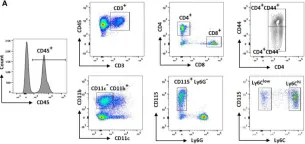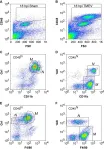Testicular tissues are highly vulnerable to oxidative stress and external insults due to their unique physiological microenvironment; thus, developing protective interventions is critical. We reveal that preconditioning through short-term stress-induced sympathetic nervous system (SNS) activation effectively mitigates testicular ischemia-reperfusion injury (IRI) in mice. Pre-activation of the SNS via diverse stressors markedly reduced seminiferous tubular damage and oxidative biomarkers compared to untreated controls. Mechanistically, the protective effect is mediated by dopamine-beta hydroxylase-expressing neurons in the rostral ventrolateral medulla (DBHRVLM), which enhance sympathetic innervation in the testes. Optogenetic and chemogenetic approaches confirmed that DBHRVLM neuron activation elevates testicular norepinephrine levels and attenuates tissue damage. Furthermore, we identify testicular macrophages as one of key mediators of this protection, demonstrating their immunomodulatory response to sympathetic signaling. These results support the "good stress" hypothesis, underscoring the beneficial effects of acute stress. Since the short-term stress response is a conserved adaptive mechanism in mammals, our findings suggest that SNS-mediated preconditioning could extend beyond testicular protection, potentially offering therapeutic insights for other oxidative stress-sensitive organs.
© 2025. The Author(s).
Product Citations: 84
In Journal of Neuroinflammation on 23 July 2025 by Liu, L., Xu, R., et al.
-
Immunology and Microbiology
In Science Advances on 27 June 2025 by Laaker, C., Kovács, K. G., et al.
Cerebrospinal fluid (CSF) contains inflammatory cues that enable peripheral immune surveillance of the central nervous system (CNS). While some cranial nerves allow for CSF efflux, the immune environment around CSF-interfacing cranial nerves during neuroinflammation is still poorly understood. Using a mouse model of multiple sclerosis [experimental autoimmune encephalomyelitis (EAE)] and CNS Mycobacterium tuberculosis infection (CNS-Mtb), we examined immune responses around olfactory nerve bundles near the cribriform plate, a key CSF efflux route. During neuroinflammation, we found increased perineural immune cells that had access to intracranial injected beads, dye, and bacteria. Additionally, we identified osseous channels connecting the environment surrounding olfactory nerves to bone marrow in the cribriform plate (cpBM). Notably, the cpBM undergoes myelopoiesis during EAE, has access to components of intracranial drainage, and is vulnerable to Mtb bacteria invasion during CNS-Mtb infection. Our findings improve the understanding of how the environments of CSF-interfacing cranial nerves and bone marrow are altered within the skull during neuroinflammatory disease.
-
Immunology and Microbiology
-
Neuroscience
In STAR Protocols on 20 June 2025 by De Leo, A., Ugolini, A., et al.
Lysine lactylation is a distinctive histone modification that plays a crucial role in epigenetic regulation and gene transcription. Here, we present a protocol for studying the genomic profile of histone lactylation with the CUT&RUN assay in tumor-associated macrophages. We describe steps for preparing live cells, gating strategies for isolating glucose transporter type 1 + (GLUT1+) monocyte-derived macrophages (MDMs) by fluorescence-activated cell sorting (FACS), binding lactyl-specific primary antibodies, and quantifying DNA using qPCR. This protocol is applicable to both tumor-derived and in-vitro-generated bone-marrow-derived macrophages. For complete details on the use and execution of this protocol, please refer to De Leo et al.1.
Copyright © 2025 The Author(s). Published by Elsevier Inc. All rights reserved.
-
Cancer Research
-
Genetics
In BMC Immunology on 14 January 2025 by Lee, S. I., Kim, N. Y., et al.
Interleukin-6 (IL-6) plays a central role in sepsis-induced cytokine storm involving immune hyperactivation and early neutrophil activation. Programmed death protein-1 (PD-1) is associated with sepsis-induced immunosuppression and lymphocyte apoptosis. However, the effects of simultaneous blockade of IL-6 and PD-1 in a murine sepsis model are not well understood.
In this study, sepsis was induced in male C57BL/6 mice through cecal ligation and puncture (CLP). IL-6 blockade, PD-1 blockade, or combination of both was administered 24 h after CLP. Peripheral blood count, cytokine level, lymphocyte apoptosis in the spleen, neutrophil infiltration in the lungs and liver, and survival rate were measured. The mortality rate of the IL-6/PD-1 group was lower, though not statistically significant (p = 0.164), than that of CLP mice (75.0% vs. 91.7%). The IL-6/PD-1 group had lower neutrophil percentage and platelet count compared with the CLP group; no significant difference was observed in other cytokine levels. The IL-6/PD-1 group also showed reduced T lymphocyte apoptosis in the spleen and decreased neutrophil infiltration in the liver and lungs.
IL-6/PD-1 dual blockade reduces neutrophil infiltration, lymphocyte apoptosis, and bacterial burden while preserving tissue integrity in sepsis. Although the improvement in survival was not statistically significant, these findings highlight its potential as a therapeutic approach in sepsis.
© 2025. The Author(s).
-
FC/FACS
-
Mus musculus (House mouse)
-
Immunology and Microbiology
In IScience on 20 December 2024 by Li, J., Mei, B., et al.
Reprogramming tryptophan metabolism (TRP) may be able to overcome immunosuppression and restore the immune checkpoint blockade (ICB) response in patients with epithelial ovarian cancer (EOC) resistant to ICB therapy because TRP metabolism is involved in the kynurenine/indole and serotonin pathways of tryptophan metabolism. Herein, employing amitriptyline (AMI), an antagonist of TLR4 and serotonin transporter (SERT), we revealed that AMI remodels the immunological landscape of EOC. In particular, AMI lowered the expression of IDO1, IL-4I1, and PD-L1, the quantity of KYN and indoles, and the level of immunosuppressive immune cells MDSC, Tregs, and CD8+CD39+/PD-1+ T cell. AMI boosted the killing potential of anti-PD-1-directed CD8+T cells and worked in concert with PD-1 inhibitors to suppress tumor growth and to prolong the survival of EOC-bearing mice. This work highlights AMI as an effective regulator of ICB response by manipulating EOC cell TRP metabolism, indicating it could be a potential strategy for improving EOC ICB therapy.
© 2024 The Author(s).
-
FC/FACS
-
Mus musculus (House mouse)
-
Biochemistry and Molecular biology
-
Cancer Research
-
Cell Biology
In Front Immunol on 5 January 2021 by Huaman, M. A., Qualls, J. E., et al.
Fig.3.A

-
FC/FACS
-
Collected and cropped from Front Immunol by CiteAb, provided under a CC-BY license
Image 1 of 2
In J Neuroinflammation on 9 March 2012 by Howe, C. L., Lafrance-Corey, R. G., et al.
Fig.2.A

-
FC/FACS
-
Mus musculus (House mouse)
Collected and cropped from J Neuroinflammation by CiteAb, provided under a CC-BY license
Image 1 of 2

